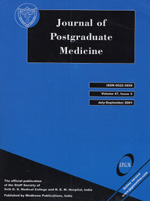
|
Journal of Postgraduate Medicine
Medknow Publications and Staff Society of Seth GS Medical College and KEM Hospital, Mumbai, India
ISSN: 0022-3859
EISSN: 0022-3859
Vol. 48, No. 3, 2002, pp. 203-205
|
 Bioline Code: jp02069
Bioline Code: jp02069
Full paper language: English
Document type: Research Article
Document available free of charge
|
|
|
Journal of Postgraduate Medicine, Vol. 48, No. 3, 2002, pp. 203-205
| en |
Case Report - Spontaneous Aortocaval Fistula
Rajmohan B
Abstract
Spontaneous aortocaval fistula is rare, occurring only in 4% of all ruptured abdominal aortic aneurysms. The physical signs can be missed but the presence of low back pain, palpable abdominal aortic aneurysm, machinery abdominal murmur and high-output cardiac failure unresponsive to medical treatment should raise the suspicion. Pre-operative diagnosis is crucial, as adequate preparation has to be made for the massive bleeding expected at operation. Successful treatment depends on management of perioperative haemodynamics, control of bleeding from the fistula and prevention of deep vein thrombosis and pulmonary embolism. Surgical repair of an aortocaval fistula is now standardised repair of the fistula from within the aneurysm (endoaneurysmorraphy) followed by prosthetic graft replacement of the aneurysm. A case report of a 77-year old woman, initially suspected to have unstable angina but subsequently diagnosed to have an aortocaval fistula and surgically treated successfully, is presented along with a review of literature. (J Postgrad Med 2002;48:203-205)
Keywords
Aortocaval fistula, aortic aneurysm rupture, imaging, endoaneurysmorraphy, auto-transfusion, endovascular stent
|
| |
© Copyright 2002 Journal of Postgraduate Medicine. Online full text also at http://www.jpgmonline.com
Alternative site location: http://www.jpgmonline.com
|
|
